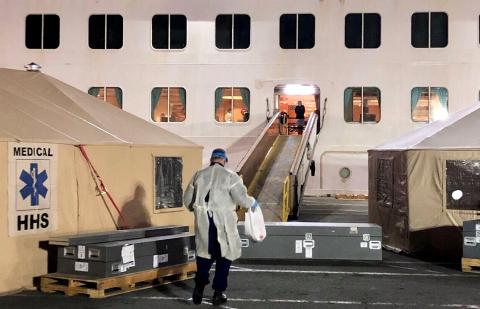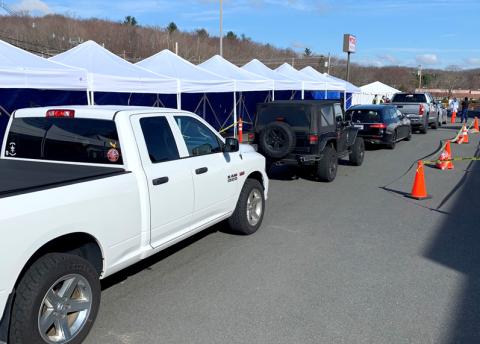NIH Safety Officer Serves on Multiple Missions

Photo: HHS
On a normal day, hundreds of officers from the Public Health Service Commissioned Corps go about their regular duties at NIH. But these have not been normal days.
Most of these uniformed health professionals—there are more than 6,100 working across government agencies—become emergency responders when crisis hits.
One of these is Lcdr. Brian Czarnecki, who normally works as an industrial hygienist at NIH’s Division of Occupational Health and Safety (DOHS). Starting in early February, he was deployed as a safety officer and process engineer assisting on multiple missions in the Covid-19 response.
In early February, Czarnecki headed to Miramar Marine Corps Air Station in San Diego, to receive and quarantine hundreds of Americans traveling home from Wuhan, China. Two weeks later, he traveled to Yokohama, Japan, where he helped disembark 360 Americans from the Diamond Princess cruise ship and escort them onto U.S.-bound planes for quarantine. He also assisted with swabbing to test all first responders on that mission.

In early March, Czarnecki returned to NIH and, on his off-hours, worked on a team that developed a covid testing concept-of-operations for occupants of the Grand Princess cruise ship off the coast of California.
Later that month, Czarnecki headed to Washington, D.C., to help develop a model for community-based testing sites. He then went north to a private partner location in Shrewsbury, Mass., to help launch the pilot, which became the first federal drive-through testing facility.
“Our team processed about 30 tests per hour, for the better part of each day, focusing on health care workers, first responders and the elderly with symptoms,” said Czarnecki.
Further working to safeguard Americans, he served on a task force to evaluate the specifications of personal protective equipment being procured by the federal government. Throughout his missions, safety was a priority as responders monitored the burn rate of PPE, to maximize supplies.

“Promoting safety as the most important priority helped ensure the team was protected during their missions in California, Japan and Boston,” said Czarnecki. As a testament to their vigilance, despite being near people who tested positive for covid, he and his fellow responders were able to serve safely.
“Modifying our own behaviors during the early stages of the outbreak—avoiding shaking hands and sharing common items, regularly wearing a mask and maintaining a social distance—were perceived as odd before it became a norm in our society,” he said. Now, it seems awkward to shake hands, not wear a mask or encroach on someone’s personal space, he noted.
Czarnecki’s day job at NIH involves anticipating, evaluating and mitigating occupational hazards, everything from biological and chemical agents to physical hazards.
“Because NIH is such a diverse place, I get a lot of different experiences here that allow me to have a well-rounded approach and prepare for various contingencies on a deployment,” he said.
Now back at NIH, Czarnecki has returned to Bldg. 13, sharing his frontline experiences with his NIH team. He expressed gratitude to both family and colleagues who assumed the burden of duties in his absence.
“I am forever grateful for the full support of NIH leadership that adjusted workflows as needed in my absence, for the full support of my NIH co-workers who backfilled my position, and the full support of my bride and children that assumed all household responsibilities,” said Czarnecki. “These people are truly unsung heroes.”
